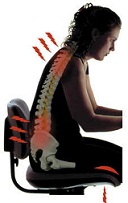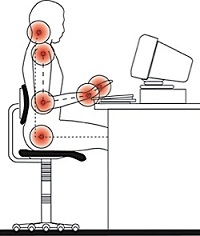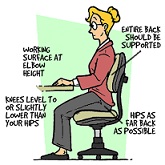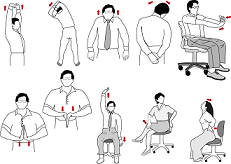Precautions to Avoid Repetitive Strain Injury – The RSI Protocol
Reviewed by: Dr Swamy K B | Author: Manoja Kalakanti
In the last two decades, it has been observed that lakhs of healthy computer users have developed and are developing a painful debilitating and sometimes disabling condition known as Repetitive Strain Injury (RSI). This condition has been described by Occupational Safety and Health Problem (OSHP) as the important occupational safety and health problem in the western countries today. We need to take few precautions to avoid Repetitive Strain Injury. RSI is not a diagnostic term or a disease. It is an umbrella term referring to work related symptoms in computer users caused by continuous work in a static posture.
Super imposed on this static posture are highly repetitive actions, such as typing on a keyboard, which give in the name diffuse disorder of soft tissue muscle, fascia, tendons and neuro vascular structures. So, whenever you are working continuously, try out few simple stress buster exercises instead sitting at the same place for a long period.
Nearly a quarter of all computer users worldwide (vocational and leisure) are estimated to have RSI. In India, statistical surveys reveal that up to 75% of population working in the IT, BPO and call centre industry are at risk and exhibiting symptoms of RSI. RSI is not unique to computer users but also prevalent in manual workers. In order to avoid these kind of injuries, it is always recommended to follow the basic guidelines for yoga practice and perform few knee, neck and elbow exercises. So here are few factors and precautions to avoid repetitive strain injury.
Predisposing Ergonomic Factors
- Lack of appropriate breaks
- Poorly fitting furniture
- Mouse, key board or monitor too high/too low
- Direct mechanical pressure on tissues
- Resting the arm or wrist on the hard surface while typing
- Cold work environment
- Work station design
- Have poor posture, don’t exercise regularly
Predisposing Postural Factors
- Static loading or holding a posture which promotes muscle tension for a long period
- Head forward position (this could be due to monitor being far away or front size being too small)
- Rounded back
- Protracted shoulders
- Bizarre leg position
- Prolonged repetitive, force full, or awkward hand movements
- Holding ones phone between head and shoulder
Symptoms
When the computer users starts developing pain in the neck and upper limb (shoulder, arm, elbow, forearm, wrist, hand) he/she should be aware that it could be the beginning of RSI. It need not be pain, but even burning, numbness, stiffness, tingling in the fingers, arms, shoulder, neck or back. Some patients complain of a constant need to stretch or manage one’s arms or weakness hands or fore arms. So, it is always better to practice few important yoga exercises for neck pain, knee joints and back.
RSI can be staged according to its severity. The initial stage is when the person develops pain during the day which vanishes whenever he takes a break. Stage two when the pain comes on during the day and does not recede till he goes back home. If however he neglects these red flags, he goes into stage three which is constant pain, irrespective to time, day or posture. This is because slow accumulation of injury occurs with gradual development of difficulty in day to day activities.
Disorders classified under RSI
A whole lot of disorders of the musculoskeletal system are classified under RSI, and could be due to purely ergonomic factors; the list is growing and can never be complete:
- edema
- Tendinitis
- Bursitis
- tenosynovitis
- De quervain’s syndrome
- Thoracic outlet syndrome
- Trigger finger/thumb
- Myofascial pain syndrome
- Carpal tunnel syndrome
- Cubital tunnel syndrome
- Medical epicondylitis (golfers elbow)
- Lateral epicondylitis (tennis elbow)
- Tremors
- Scalenus anterior tenderness stiffness
- Trapezius tenderness/stiffness
- Supraspinatus tendinitis
Precautions to Avoid Repetitive Strain Injury
Ergonomics
There is growing awareness of the scale of work related ill health linked to musculoskeletal disorders and stress. Ergonomics is concerned with the fit between people and their work, the branch of science that assesses human anthropometric measurements and abilities and then applies that knowledge to improve people’s interaction with products, systems and environment. It is the science of fitting the job to the worker; emphasis has to be given to modifying the work station. Unfortunately, in India the awareness of RSI and its impact on health is very poor.
Management of RSIArrangement of the work station
The position of the chair, the monitor, lighting and the contour of the desk are all taken into consideration. The occupational safety and health administration (OSHA) has put guidelines, not only for office ergonomics but also for various occupations such as load handling, mining, and agriculture related occupations.
Relative Rest
Relative rest means avoiding pain producing activities. Regular periods of rest during work hours are must.
Key Exercise to avoid RSI
Exercise is one of the key elements in the successful outcome. It is recommended by OSHA that computer user should move around 5 minutes every hour during intensive computer use. He or she must stretch; use recommended stretching called computer break.
Some of the exercises are: Shift positions frequently and vary the work routines.
Many companies provide facilities so that their employees participate in a regular fitness program away from work. Improve sitting posture, reduce excessive kyphosis.
These are the precautions to avoid Repetitive Strain Injury. Computer break exercises are prescribed to prevent RSI. These are the simple stretches to the neck like neck rods/neck rotation, shoulder away/shoulder shrug, and stretches to elbow hand, arm, fore arm that can be even done in front of the computer. Strengthening exercises correct breathing pattern.








Manoja Kalakanti